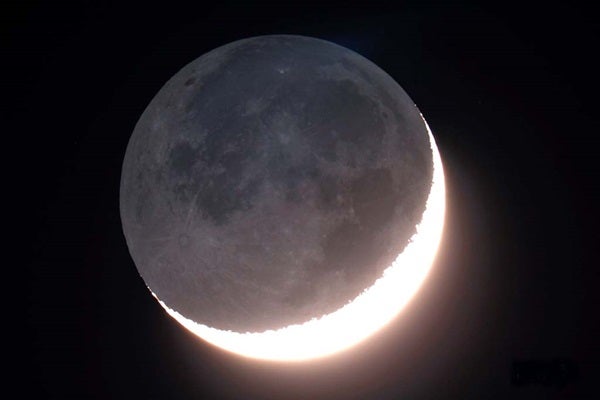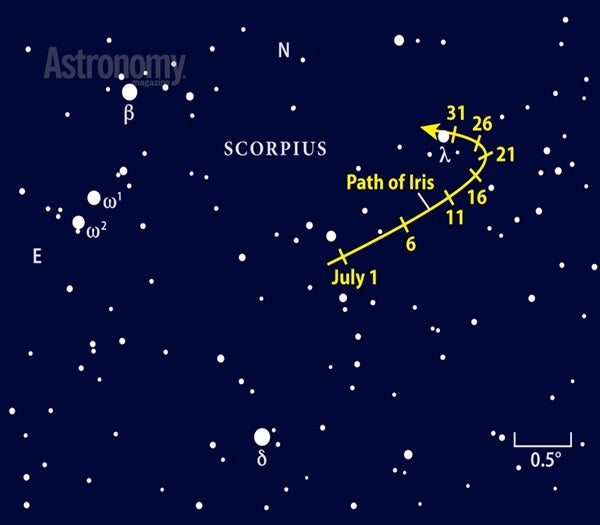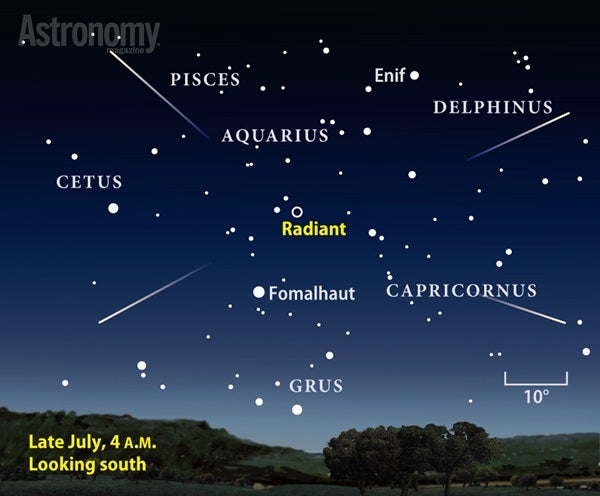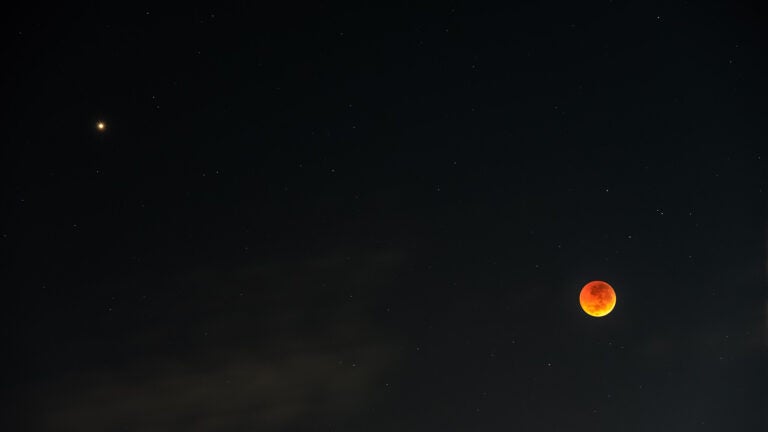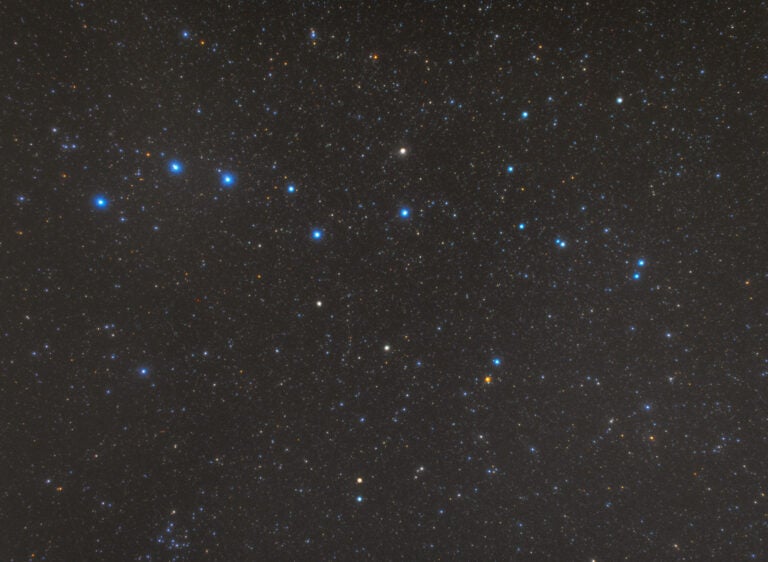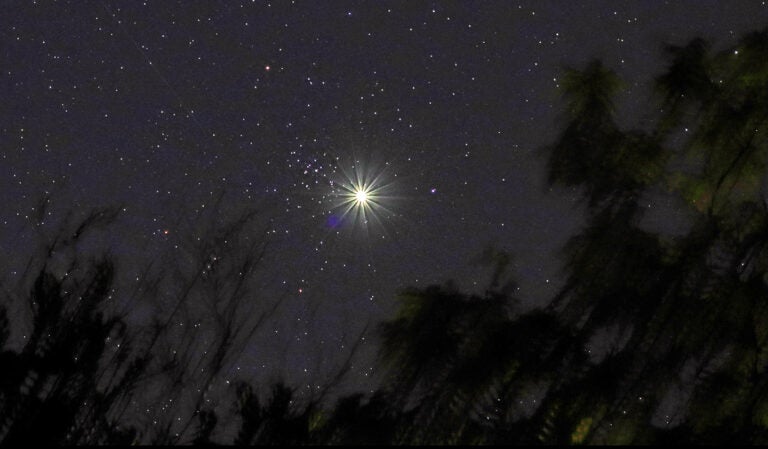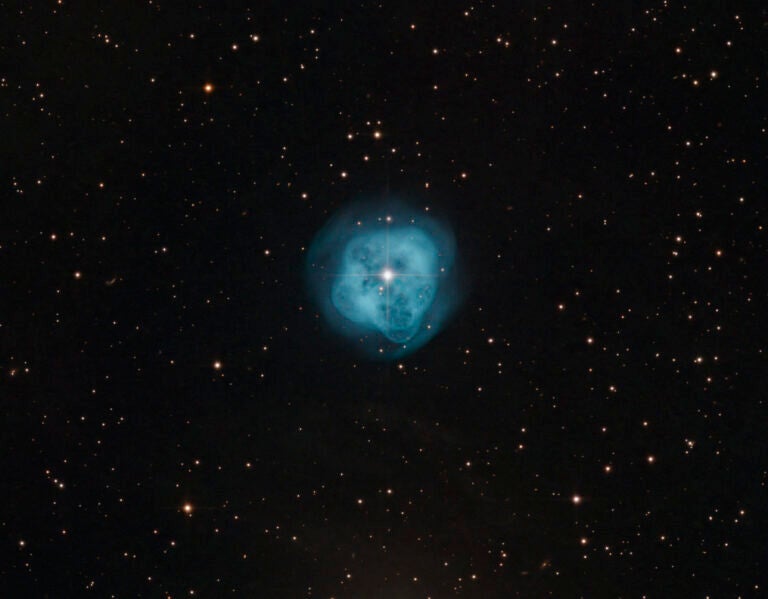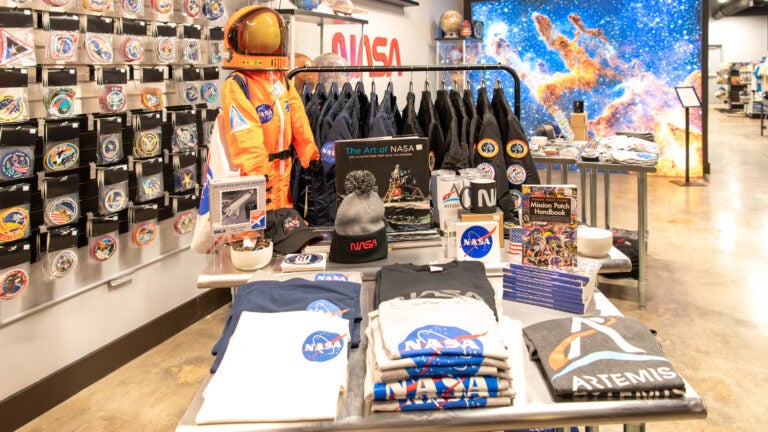Friday, July 8
The Moon passes 1° south of Jupiter tomorrow morning, unfortunately after the two objects have dipped below the western horizon. But the view this evening is nearly as nice. The waxing crescent Moon stands 3° to 5° (depending on where in North America you live) to the planet’s lower right. Tomorrow evening, a slightly fatter crescent Moon will appear about twice as far to Jupiter’s upper left. Although the Moon’s presence is only temporary, the planet remains a fixture in the evening sky all week. It appears striking in the west as darkness falls and remains on display until after 11 p.m. local daylight time. Jupiter shines at magnitude –1.8 against the backdrop of southern Leo the Lion. The gas giant appears equally dazzling through a telescope, which reveals a wealth of atmospheric features on a disk that spans 34″.
Saturday, July 9
Look toward the south as darkness falls and you can’t help but see Mars. The Red Planet shines brilliantly at magnitude –1.2 — trailing only the Moon and Jupiter after dusk — against the much fainter background stars of Libra. And it remains visible until it dips below the southwestern horizon around 2 a.m. local daylight time. When viewed through a telescope, Mars’ orange-red disk spans 15″ and shows a number of subtle dark markings. You also might glimpse the white north polar cap, which should be near its minimum extent now because summer ended in the planet’s northern hemisphere just last week.
Sunday, July 10
This should be a good night to hunt down asteroid 7 Iris through a small telescope. The 10th-magnitude object lies nearly due south and at its highest position in the sky as darkness falls. Even better, there’s a reasonably bright guide star to point you in the right direction. This evening, look for Iris 0.5° due south of the magnitude 5.0 star Lambda (l) Librae.
Monday, July 11
You can find the First Quarter Moon in the southwest as darkness falls, then watch as it sinks toward the western horizon, where it sets shortly before 1 a.m. local daylight time. Our satellite officially reaches its First Quarter phase at 8:52 p.m. EDT. The half-lit Moon spends the night among the background stars of Virgo the Maiden, some 5° north of that constellation’s brightest star, 1st-magnitude Spica.
Saturn lies nearly due south and at its peak altitude as darkness falls this week. Shining at magnitude 0.2, it is easily the brightest object in its host constellation, Ophiuchus the Serpent-bearer. When viewed through a telescope, the planet measures 18″ across while its dramatic ring system spans 41″ and tilts 26° to our line of sight. You also should keep an eye out for its brighter moons. A 4-inch scope easily shows 8th-magnitude Titan and the 10th-magnitude trio of Tethys, Dione, and Rhea. An 8-incher will bring in two more satellites that are well-placed this evening. Look for 11th-magnitude Iapetus 2.2′ north of Saturn and 12th-magnitude Enceladus 35″ west of the planet.
Tuesday, July 12
Pluto reached opposition and peak visibility last week, and it remains a tempting target all night. It glows dimly at magnitude 14.1, however, so you’ll need an 8-inch or larger telescope with good optics to spot it visually. Pluto currently lies in northeastern Sagittarius, some 0.4° west-southwest of the 3rd-magnitude star Pi (p) Sagittarii. See “The quest for distant Pluto” in the July Astronomy for complete details on finding this world.
Wednesday, July 13
The Southern Delta Aquarid meteor shower gets underway this week. Although the shower doesn’t peak until the end of July, you should start to see some meteors in the hours before dawn. The best time to look is between 3 and 4 a.m. local daylight time, after the Moon has set and before twilight intrudes. To tell a Southern Delta Aquarid meteor from a random dust particle burning up in Earth’s atmosphere, trace the streak of light’s path backward. A shower meteor will appear to originate from the constellation Aquarius the Water-bearer.
The Moon reaches apogee, the farthest point in its orbit around Earth, at 1:24 a.m. EDT. It then lies 251,201 miles (404,269 kilometers) from Earth’s center.
Thursday, July 14
The waxing gibbous Moon forms a flat triangle with Mars and Saturn tonight. The Moon stands highest and about 8° to Mars’s upper left once darkness falls; Saturn lies approximately 16° to the Red Planet’s left.
Friday, July 15
For observers in North America, the Moon appears 3° above Saturn this evening. The ruddy 1st-magnitude star Antares in Scorpius the Scorpion lies 10° below the Moon while Mars blazes well to the trio’s right.
Saturday, July 16
If you like observing challenges, tonight is your night. Mercury passes just 0.5° (the diameter of a Full Moon) north of Venus in the early evening sky. From 40° north latitude, the two lie less than 4° high in the west-northwest 20 minutes after sunset. With a flat horizon and pristine skies, you might just glimpse the pair through binoculars. At magnitude –3.9, Venus will be the easier of the two to spot (Mercury glows at magnitude –1.0).
Sunday, July 17
Observers of the outer solar system should target Uranus this week before the Moon sheds its unwanted light into the predawn sky. The best time to look for it is shortly before twilight begins around 4 a.m. local daylight time. Uranus then lies 40° high in the northeast among the background stars of Pisces the Fish. This morning, use binoculars to find the magnitude 5.8 planet about 4° west of 4th-magnitude Omicron (o) Piscium and 3° north of 5th-magnitude Mu (m) Psc. A telescope reveals Uranus’ blue-green disk, which spans 3.5″.

